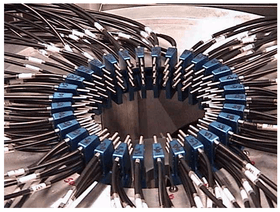Diffuse optical imaging
Diffuse optical imaging (DOI) is a method of imaging using near-infrared spectroscopy (NIRS)[1] or fluorescence-based methods.[2] When used to create 3D volumetric models of the imaged material DOI is referred to as diffuse optical tomography, whereas 2D imaging methods are classified as diffuse optical topography.

The technique has many applications to neuroscience, sports medicine, wound monitoring, and cancer detection. Typically DOI techniques monitor changes in concentrations of oxygenated and deoxygenated hemoglobin and may additionally measure redox states of cytochromes. The technique may also be referred to as diffuse optical tomography (DOT), near infrared optical tomography (NIROT) or fluorescence diffuse optical tomography (FDOT), depending on the usage.
In neuroscience, functional measurements made using NIR wavelengths, DOI techniques may classify as functional near infrared spectroscopy fNIRS.
See also
- Optical tomography
- Computed tomography laser mammography
- Diffusive optical imaging in neuroscience
References
- Durduran, T; et al. (2010). "Diffuse optics for tissue monitoring and tomography". Rep. Prog. Phys. 73: 076701. doi:10.1088/0034-4885/73/7/076701. PMC 4482362.
- "Harvard.edu Diffuse Optical Imaging". Archived from the original on June 16, 2012. Retrieved August 20, 2012.